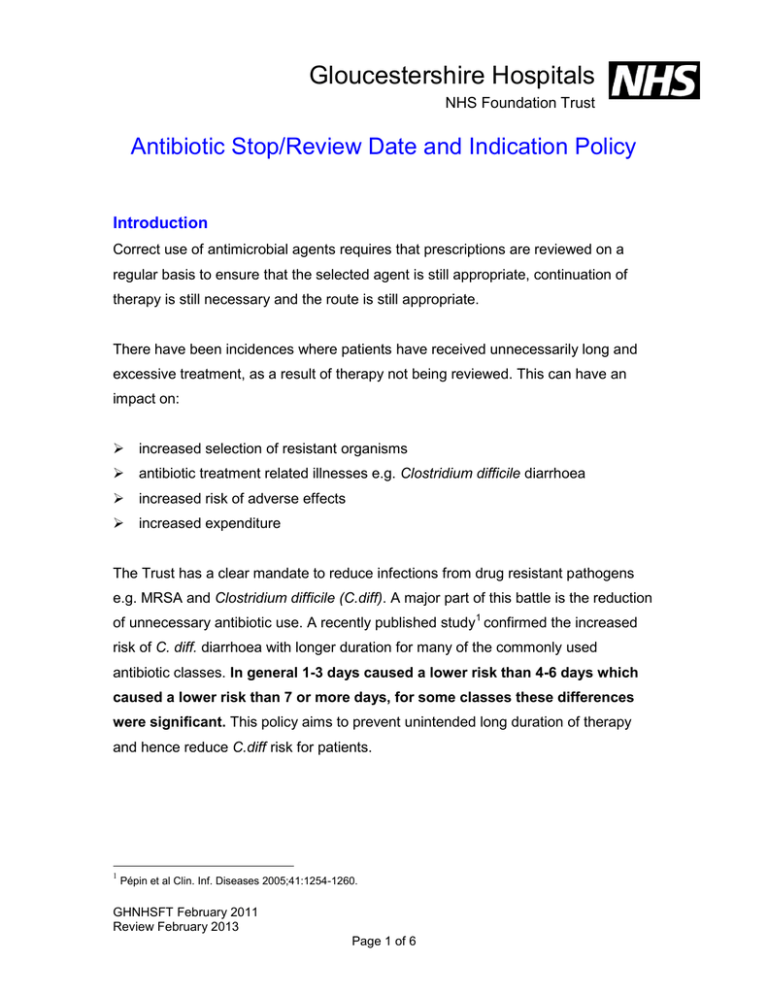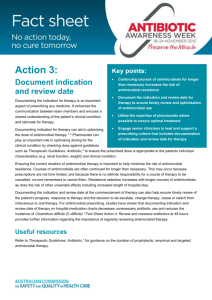Antibiotic Stop/Review Date and Indication Policy
advertisement

Gloucestershire Hospitals NHS Foundation Trust Antibiotic Stop/Review Date and Indication Policy Introduction Correct use of antimicrobial agents requires that prescriptions are reviewed on a regular basis to ensure that the selected agent is still appropriate, continuation of therapy is still necessary and the route is still appropriate. There have been incidences where patients have received unnecessarily long and excessive treatment, as a result of therapy not being reviewed. This can have an impact on: increased selection of resistant organisms antibiotic treatment related illnesses e.g. Clostridium difficile diarrhoea increased risk of adverse effects increased expenditure The Trust has a clear mandate to reduce infections from drug resistant pathogens e.g. MRSA and Clostridium difficile (C.diff). A major part of this battle is the reduction of unnecessary antibiotic use. A recently published study1 confirmed the increased risk of C. diff. diarrhoea with longer duration for many of the commonly used antibiotic classes. In general 1-3 days caused a lower risk than 4-6 days which caused a lower risk than 7 or more days, for some classes these differences were significant. This policy aims to prevent unintended long duration of therapy and hence reduce C.diff risk for patients. 1 Pépin et al Clin. Inf. Diseases 2005;41:1254-1260. GHNHSFT February 2011 Review February 2013 Page 1 of 6 The addition on the medicine chart of a stop date or intended duration of treatment every time an order for an antimicrobial agent is made, has worked successfully in many hospitals. Pharmacists and nurses facilitate the policy as part of their role on the wards. The indication for an antimicrobial agent is often not clear or easy to find in the notes and makes monitoring for appropriateness by other clinicians and health professionals difficult. In many cases the prescriber initiating the antimicrobial may not be available to regularly review it (due to shift working). It would therefore be very beneficial to have the indication written on the medicine chart for all orders of antimicrobial agents. Overall, documenting the indication and intended stop date/duration on the drug chart will be beneficial to all and help prevent unnecessarily extended antibiotic courses. The Policy All prescribers must write a stop/review date and indication on the medicine chart for all orders of antimicrobial agents. Standard An indication and a stop/review date or intended duration should be specified on the medicine chart at the point of prescribing any antimicrobial agent (when an order for antimicrobial therapy is made.) Audit This will be an ongoing campaign monitored by the six monthly Point Prevalence Studies. Outcome measures: % compliance, changes in antibiotic usage, changes in mean duration and savings on antibiotic expenditure. GHNHSFT February 2011 Review February 2013 Page 2 of 6 APPENDIX 1 A. Actions For Doctors Write the indication and stop/review date or intended duration in the „additional instructions‟ box on the medicine chart for each antimicrobial agent prescribed. The abbreviated indication (e.g. UTI) should be as specific as is known at the time of prescribing e.g. “sepsis ?cause” maybe appropriate if there really are no clinical features. This should be updated as more information is available. Rarely, for confidentiality reasons, it is not deemed appropriate for the indication of the antimicrobial to be written on the drug chart (e.g. HIV). In these cases, please ensure it is written clearly in the medical notes and add "see notes" along with the stop or review date on the drug chart. The majority of IV antibiotics will require a “review” rather than “stop” date prior to being converted to oral. Review doses should be targeted for lunchtime doses where possible and should avoid weekends unless the patient is due for daily consultant review. Antibiotic review should be documented on the chart e.g. crossing through “r/v” and writing “give” plus endorsing a new review date. For some infections, e.g. empyema, it may be difficult to endorse a definite stop date until the patient‟s condition begins to improve. Antibiotics in these circumstances should have review dates about twice a week (e.g. at consultant ward rounds and/or Fridays). Following an IV to PO switch. Please indicate the duration as either: “… days more” i.e. … days of oral following IV therapy, “… days total” i.e. the total required duration of IV and PO together or put a stop date (e.g. “stop 14/6/06”). Antibiotics should be stopped/reviewed earlier than the specified date if clinically indicated. Example with stop date (mostly appropriate for oral therapy): 06.00 Trimethoprim DOSE Other e.g. ml 200 Mcg mg Directions bd g Route po Additional instructions UTI 3 days Start Date Stop Date Signature Bleep 2.8.07 5.8.07 A.Dr 1111 2/8 /07 3/8 /07 4/8 /07 5/8 /07 Continue On TTO 08.00 12.00 14.00 Supply ... Days Advice to continue Y / N Signature DRUG APPROVED NAME PLEASE PRINT 18.00 22.00 PHARMACY USE GHNHSFT February 2011 Review February 2013 Page 3 of 6 Example with review date (mostly appropriate for initial IV therapy): Flucloxacillin DOSE 1 Mcg mg Start Date 3.8.07 Other e.g. ml g Stop Date Directions Additional instructions qds Cellulitis Review 48 hrs Route IV Signature Bleep A.Dr 1111 06.00 2/8 /07 3/8 /07 4/8 /07 5/8 /07 Continue On TTO 08.00 12.00 R/V 14.00 Supply ... Days Advice to continue Y / N Signature DRUG APPROVED NAME PLEASE PRINT 18.00 22.00 PHARMACY USE Typical standard course lengths (see also specific guidelines for further details) Surgical prophylaxis (standard) Surgical prophylaxis (involving implant) Non severe pneumonia (CURB65 score 0-2) Severe pneumonia of unknown aetiology (CURB65 score 3-5) Atypical community acquired pneumonia Legionella pneumonia Severe Staphylococcus aureus / PVL pneumonia Severe community acquired Gram negative pneumonia Non-pneumonic LRTI/ Infective exacerbation of COPD Infective exacerbation of bronchiectasis Hospital Acquired pneumonia Uncomplicated UTI (non-pregnant women) Uncomplicated UTI (men and pregnant women) Complicated UTI (including pyelonephritis) Wound/soft tissue infection Clostridium difficile diarrhoea Intra-abdominal sepsis Biliary sepsis Spontaneous bacterial peritonitis Pelvic inflammatory disease Post-operative gynaecological sepsis Bacterial meningitis Viral encephalitis Single dose at induction no longer than 24 hours 5-7 days 7-10 days 14 days 14-21 days 14-21 days 14-21 days 5 days (For severity C 7-10 days) 14 days 7-8 days 3 days 7 days 10-14 days 7 days and then review 10-14 days 5-7 days and then review 7 days 5-7 days and then review 14 days 5-7 days and then review 5 days minimum and then review 10-21 days NB Clinical judgement is still required, some patients/minor infections will not require the full standard course length detailed above - shorter courses of antibiotics equate to a lower risk of C. difficile diarrhoea. GHNHSFT February 2011 Review February 2013 Page 4 of 6 Please note the following conditions normally require an extended course Acute Prostatitis Tuberculosis Osteomyelitis Prophylaxis for PCP/splenectomy Endocarditis Necrotising soft tissue infections Meningitis/ Brain Abscess Infected implants/prosthesis Septic Arthritis Mediastinitis Empyema Exacerbation of CF/bronchiectasis Staphylococcus aureus bacteraemia Missed doses Antibiotic doses may be missed for a number of reasons (e.g. no cannula, unable to swallow). Patients should be reviewed clinically and consideration given for represcribing additional doses if required. B. Actions For Nurses Request the doctor to write the stop/review date and indication on the medicine chart for all orders of antimicrobial agents. Query all prescriptions continuing beyond the stop/review dates. Whilst awaiting review, continue to administer the antimicrobial. Ask doctor to review if a number of doses have been missed during the prescribed course, especially if the patient is still unwell or at a weekend where regular review is unlikely. C. Action For Pharmacists All pharmacists should request a stop/review date and indication to be written in the „additional instructions‟ box on the medicine chart for all antimicrobial agents. If the prescription is written in the presence of a pharmacist, request a stop/review date and indication as part of the prescription writing process. If a stop date has been documented the pharmacist may alter the administration boxes to ensure nurses do not give a longer course than was intended. Clarithromycin DOSE 500 Mcg mg Start Date 3.8.07 Other e.g. ml g Stop Date Directions Additional instructions bd C.A.P. 7 days Route po Signature Bleep A.Dr 1111 06.00 2/8 /07 3/8 /07 4/8 /07 5/8 /07 Continue On TTO 08.00 12.00 14.00 Supply ... Days Advice to continue Y / N Signature DRUG APPROVED NAME PLEASE PRINT 18.00 22.00 PHARMACY USE If a review date has been documented by the doctor, the pharmacist should highlight and endorse „R/V‟ around the appropriate administration box. If GHNHSFT February 2011 Review February 2013 Page 5 of 6 possible, choose a weekday lunchtime dose: For all prescriptions already written, contact the prescriber and request a stop date and indication then endorse the chart appropriately. Inform the prescriber that the standard is to include a stop date and indication every time an order for an antimicrobial agent is made. This request should be made within 48-72 hours of the prescription being written. If this is not possible write in the notes requesting for a stop date and indication for the antimicrobial agent. If the stop date has not been written by day 5 of treatment, inform the prescriber that this will be referred to the Antibiotic pharmacist/ Consultant microbiology ward round if the indication/stop date are not written on the medicine chart for the antibiotic on day 7 of treatment. If the stop date has not been written by day 7 of treatment, refer the patient to the lead Antibiotic Pharmacist. DRUG APPROVED NAME PLEASE PRINT Tazocin 4.5 Mcg mg Start Date 3.8.07 Other e.g. ml g Stop Date Additional instructions tds H. A. P. Review 24hrs IV 3/8 /07 4/8 /07 5/8 /07 Continue On TTO 08.00 Directions Route 2/8 /07 Signature Bleep A.Dr 1111 12.00 14.00 18.00 R/V 22.00 PHARMACY USE GHNHSFT February 2011 Review February 2013 Page 6 of 6 Supply ... Days Advice to continue Y / N Signature DOSE 06.00

![Professor Anthony Kessel, Director of Public Health Strategy, Health Protection Agency [PPT 10.39MB]](http://s2.studylib.net/store/data/015100065_1-52ef62fa093dba928ff11f1845be5aa1-300x300.png)


